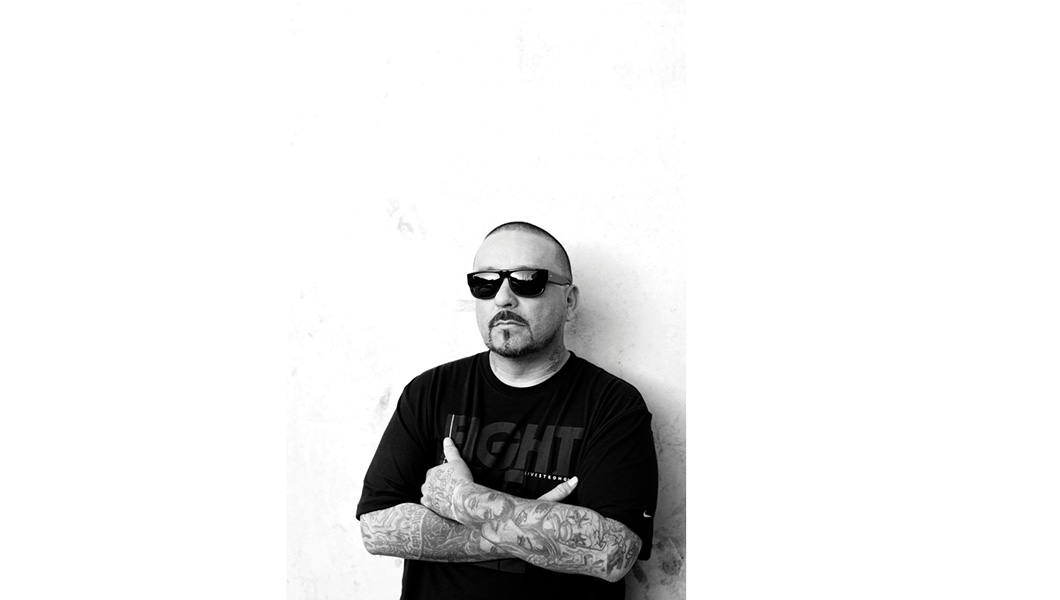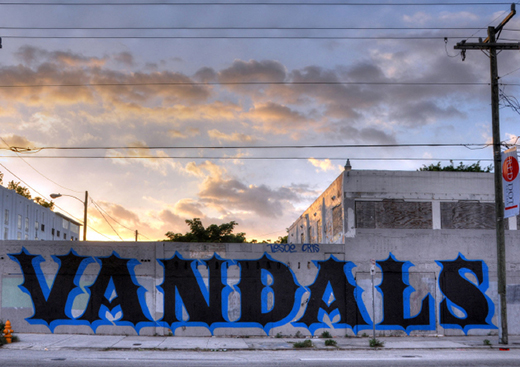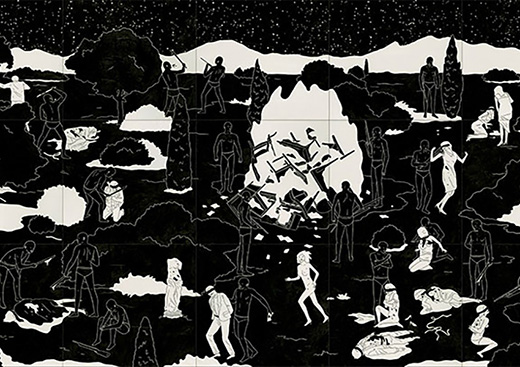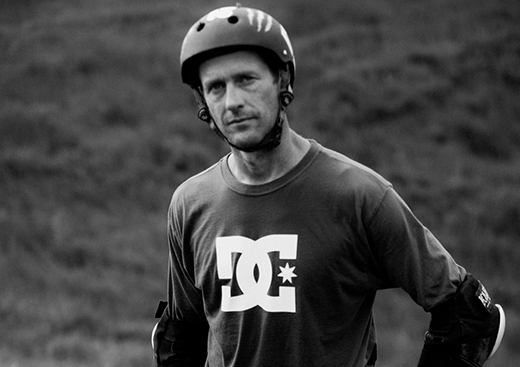If Mark Machado wasn’t the legendary tattoo artist known as Mister Cartoon, he could have been a poet. Or a rap star. Or a therapist. Or a motivational speaker. Just like the plethora of platinum-selling recording artists he’s called clients over his superlative career (Cypress Hill, Wu Tang Clan and Outkast, among others), the proud Angeleno is a lyrical genius who can casually drop memorable morsels of wisdom on a range of subjects. Like ink on paper (or, in this case, ink on skin), his words stick with you forever. But how did Mark become Cartoon? A visit to his iconic tattoo shop in the heart of downtown Los Angeles provides further insight.
What was it like growing up in L.A.?
I had a dream childhood, raised by a good mother and father who were creative and open-minded. We lived in a neighborhood in the Harbor area, and they encouraged me as a youngster to be an artist. We weren’t rich, but we weren’t poor either. If we didn’t have any money, I didn’t even know about it because my parents were very private about themselves, and very hard workers. The time I grew up, around the 1970s and 1980s, was a crazy time. A very bad time for fashion, but a great time for music. [Laughs.] I’m 44 years old now, so I caught on the tail end of a bunch of old-school shit, music wise. I got into classic rock from hearing my parents—Pink Floyd, The Doors—then got into funk and disco. I was around when all those sounds were new on the radio. My parents were also big movie heads, so they would take me to see movies that were way too advanced for me, which gave me a really weird sense of humor. I remember seeing The Shining, The Exorcist, The Omen . Me and my cousins would be watching TV and some guy would get hit by a car and I would start laughing and they’d sit there in horror. I would find humor in some fucked-up shit, man. Then there were the street fights, graffiti, the lowrider cars—I loved it all.
Then you received your first paid art job at the age of 12.
That kind of just happened by accident. My old man had a small print shop and he had artists he worked with and they would flake all the time. He started giving me logos, business cards and restaurant menus to design, so I did that and got paid. That’s the only job I’ve ever had. I’ve never clocked in or had a supervisor or anything, which has been both a blessing and a curse. From a young age, I had to be my own boss and was never guaranteed any money.
But you had this incredible artistic talent. Didn’t the money just come?
You know, I was told that I was blessed when I was growing up. I went to Catholic school and people told me that I was gifted and talented, that God had come from the skies and zapped me and made me better than everyone else. I believed that shit for many years, until I got a lot older and started to see that it was less about being zapped from an invisible entity and more about work ethic, follow-through, grinding constantly and stretching the limit. When everyone is going home, I kept working. It’s about doing what the other guy won’t do— visually seeing where you’re going to go way before anyone else can manifest it. This tattoo shop was drawn out way before I ever got picked up. I have to have my GPS set, otherwise I’m just driving in circles. So I started to see that, for me, I wasn’t blessed or gifted or talented. It was something that, through hard work and years of trial and error, I would find my style.
How did you develop your style?
Being untrained with just a high school education, I had to learn everything on my own. When I was growing up, I started going to car shows at high schools and football fields. I’d see these guys airbrushing T-shirts, but they were really corny old men and didn’t have any swag whatsoever. I picked up an airbrush and didn’t have a clue what to do. It took a long time to perfect that craft. It was the late 1980s, so there were no clothing companies. We made our own clothes. We would go to the surplus stores and they’d sell big hoodies there. We called them blanks. We would iron on Old English letters with our street or our crew. We were making our own shit, setting things up for the West Coast. Music was a big influence, too. KDAY was the baddest radio station out there, and it inspired a lot of my artwork, which was a mix of New York graffiti bombing with L.A. cholo/ vato-style fine line. That’s how I started to get my look, by combining those two styles. The characters were a little more 3D, so shit was coming at you more than traditional old-school penitentiary style. As far as inspiration, I don’t really come with a bunch of point-of-reference pictures. Give me a pen and a paper or a can and a wall and I just go off. A lot of other artists are more calculated and do a bunch of premeditative shit, but I just draw off the dome.
When did you first realize that you had made it?
One of the first moments when I knew that I wasn’t going to have to go get a 9 to 5 job was seeing an album cover I did on Sunset Blvd. on a billboard—it was in 1992, the day the L.A. Riots happened. I remember driving from the Harbor area on the 110 Freeway going north and seeing everything on fire and was thinking, “What the fuck?” I got to Hollywood and I drove down Sunset and my billboard was right there. It was for Kid Frost’s second album, East Side Story . I blacked out and couldn’t believe it! I was in the music business now; I didn’t know how to play an instrument or know how to rap, but I was in the game like other artists were. From that point on I believed that anything could happen. Right after I did that album cover, I started doing album covers for Eazy E. Around that time I met my business partner, Estevan Oriol, at a record release party for a group called Penthouse Players, one of DJ Quik and Eazy E’s groups. He was tour manager for a new group that nobody had heard of at the time—House of Pain. They had this new single called “Jump Around,” which did pretty well, I’d say. [Laughs.]
That’s when Estevan started referring you more tattoo right.
One of the other bands he tour-managed, Cypress Hill, was the first platinum recording artist that I tattooed. They pretty much introduced me and Estevan to a lot of other rappers. Because of them, I was able to tattoo DJ Premiere, Outkast and others.
A lot of it is through your friends, you know?
Just like how a friend gets you a job at, like, Home Depot. It’s all the same shit! It’s great because celebrities get you exposure, but they come when they come. The rest of the year, it’s just regular Care to share any wild celebrity tattoo stories? One time the RZA flew me to New York and didn’t even show up. He flew me out, and I never even got to see him! I started tattooing where the Wu Tang studio was, and I tattooed a Wu Tang emblem on Method Man. I just tattooed all night in that studio—it was fucking nuts! The tables were wrong, there wasn’t any lighting, all their homies were drunk. It was probably the worst conditions in the world, but I got it done. It was just funny because homeboy went through all that trouble to fly me out, but got too busy to show up. You know, I try to talk celebs out of flying me out to their locations like that. I like to just work at my studio. Otherwise they have to pay to fly me out, fly my assistant out, etc. I always tell them, “I ride like you ride, so are you sure you want to do that? I’m going to be staying at the hotels you stayat, and I’ll need a black suburban to drive me around. You sure?” [Laughs.] It’s better to get tattooed here, honestly.
Do your four kids know that you’re famous?
My kids aren’t old enough to understand what I do. They trip because I’m just dad to them. We’ll walk into a store like Vans and see a cutout of me and they’re like, “That’s my dad!” They’re tripping. I would be a hypocrite if I told them not to be an artist, but a tattoo artist? No. Tattoo shops don’t normally look like my tattoo shop—they’re gangster spots. I think my children will grow up to be creative because they’re around it so much at home. A shoe for Vans is one of many high-profile collaborations you’ve done in recent years.
How do you avoid selling out?
I think selling out is when you put out weak work and you don’t believe in it. If they put you in a jalapeño outfit and make you moonwalk or some shit, you’re out of here. But if you produce some hardcore-looking artwork and place it on something like a cell phone, it’s completely different because it’s still you. When I’m doing something kind of big, like my own signature phone, I’ll balance it out by doing something street and limited edition with Undefeated or Stussy or Supreme. You just have to be careful with what you do. I only do collabs with people who I respect. It’s a balance of going against the grain to come up with that new shit, and keeping people so far in the rearview mirror that they don’t even see what’s coming next. But no one wants to hear Dr. Dre make Techno, so stick to your shit too.
How do you handle fame?
Fame is like being in a circus. It’s just weird. I have to watch what I complain about, though, because my friends will call me out and say things like, “Fool, that ain’t no fuckin’ problem!” I try to stick with the attitude of gratitude, and never take myself too seriously. It’s not just The Cartoon Show, either. Sometimes Estevan’s pushed up; sometimes I’m pushed up. We’ve been everywhere together, even Milan Fashion Week—it’s crazy. Fame is also about making sure that everyone is happy. Being a tattoo artist, you have to know how to get into people’s heads. It’s a constant process, and I wear many hats. I always have to keep a hat in the graffiti world, keep a hat in the lowrider world, keep a hat in the fashion world, keep a hat in tattoo world. They’re all kind of related, but they’re all completely different.
What legacy do you want to leave?
I know the common answer would be that I want everyone to remember that I had original style, but the reality is that it’s impossible to control what other people will think when I’m gone. People will be texting at my funeral. Life goes on. I have to die to move out of the way so my kids could take over. I’m sure when I’m 80 they’ll want me to die anyways! [Laughs.] It’s all about enjoying the present moment. If I can get my kids to not obsess and worry about shit and have fun in life, then I’m happy. I’m only concerned with how my children see me. You never know how much your parents loved you until you have kids.
—





